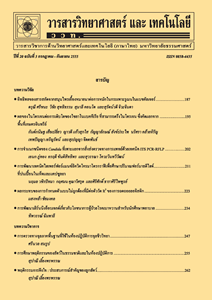การลดสารคาร์เบนดาซิมในใบกุยช่ายและการดูดสารกลับจากการล้างด้วยวิธีของกรมวิชาการเกษตร
Main Article Content
Abstract
บทคัดย่อ
การศึกษานี้ได้เปรียบเทียบวิธีการล้างผักตามคำแนะนำของกรมวิชาการเกษตร เพื่อลดสารตกค้างคาร์เบนดาซิมในใบกุยช่ายทั้งหมด 6 วิธี คือ การแช่น้ำประปา การแช่น้ำผสมน้ำส้มสายชู การแช่น้ำผสมน้ำยาล้างผัก St. Andrew การแช่น้ำผสมด่างทับทิม การแช่น้ำไหลล้น และการล้างน้ำไหลผ่านตะแกรง นาน 5-60 นาที โดยศึกษาทั้งหมด 3 ซ้ำ การสกัดคาร์เบนดาซิมใช้วิธี matrix solid phase dispersion (MSPD) และวิเคราะห์ความเข้มข้นด้วยเครื่องโครมาโตรกราฟของเหลวสมรรถภาพสูง โดยความเข้มข้นที่ได้นำมาเปรียบเทียบกับค่ามาตรฐานสารพิษตกค้างสูงสุดที่มีได้ (maximum residue limits, MRLs) ซึ่งประเทศไทยกำหนดความเข้มข้นคาร์เบนดาซิมในใบกุยช่ายไว้ไม่เกิน 3 มิลลิกรัมต่อกิโลกรัม (มก./กก.) ผลการศึกษาพบว่าวิธีการล้างน้ำไหลผ่านตะแกรงโดยไม่มีการขังของน้ำที่ใช้แช่ให้ประสิทธิภาพสูงสุดในการลดสารคาร์เบนดาซิม โดยสามารถลดเหลือเพียง 0.1-1.2 มก./กก.กุยช่าย ในเวลา 60 นาที จากปริมาณคาร์เบนดาซิมเริ่มต้น 17.3-27.2 มก./กก.กุยช่าย คิดเป็นร้อยละ 72.3-94.9 ในขณะที่วิธีที่เหลือสามารถลดสารคาร์เบนดาซิมได้ร้อยละ 54.1-99.1 โดยระยะเวลาของการแช่ในน้ำประปา การแช่น้ำผสมน้ำยาล้างผักและการแช่น้ำผสมน้ำส้มสายชูที่เหมาะสมที่สุดคือ 10 นาที เมื่อแช่ 15 นาที กลับพบปริมาณคาร์เบนดาซิมเพิ่มขึ้น ในขณะที่การแช่น้ำไหลล้นและน้ำผสมด่างทับทิม ระยะเวลาในการแช่ที่เหมาะสม คือ 5 นาที เมื่อแช่นาน 10 นาที พบว่ามีปริมาณคาร์เบนดาซิมเพิ่มขึ้นแสดงว่าอาจมีการดูดซึมกลับของสารคาร์เบนดาซิมเข้าสู่ใบกุยช่ายใหม่อีกครั้งหนึ่ง มีเพียงการล้างด้วยวิธีเปิดน้ำไหลผ่านตะแกรงเท่านั้นที่ไม่พบการดูดซึมสารคาร์เบนดาซิมกลับเข้าสู่ใบกุยช่ายเมื่อเวลาผ่านไป
คำสำคัญ : สารกำจัดรา; คาร์เบนดาซิม; ใบกุยช่าย; วิธีการล้างผัก
Abstract
A comparison among 6 washing methods as recommended by the Department of Agriculture for carbendazim reduction in Chinese chives had been made in this study. The methods were soaking the Chinese chives in i) tap water, ii) diluted vinegar, iii) St. Andrew vegetable washing solution, iv) potassium permanganate solution, v) overflowed water, and vi) running tap water through the Chinese chives in a basket without soaking. Each method was repeated 3 times for 5-60 min. Carbendazim in the Chinese chives was extracted using the matrix solid phase dispersion (MSPD) method and analyzed with an ultra-high performance liquid chromatography. The obtained carbendazim concentration was compared with the maximum residue limits: MRLs of Thailand, which is 3 mg/kg. The results revealed that running tap water through the Chinese chives in a basket without soaking yielded the highest efficiency of cleaning (72.3-94.9 %) in 60 min. This method could reduce the carbendazim from 17.3-27.2 mg/kg to 0.1-1.2 mg/kg, which was below the MRLs, while the rests yielded 54.1-99.1 % efficiency. In cases of soaking the Chinese chives in tap water, in St. Andrew solution, and in diluted vinegar, the best reductions were found in 10 min. With a 15-min soaking test; however, the carbendazim residues in the Chinese chives were increased. In cases of soaking in the overflowed water and in potassium permanganate solution, the best reductions were in 5 min and the concentration increases were also found in a 10 min soaking test. This may imply that the re-absorption of carbendazim into the Chinese chives was occurred. However, the re-absorption was not observed when the tap water was running through the Chinese chives in the basket without soaking.
Keywords: fungicide; carbendazim; Chinese chives; vegetable washing method
การศึกษานี้ได้เปรียบเทียบวิธีการล้างผักตามคำแนะนำของกรมวิชาการเกษตร เพื่อลดสารตกค้างคาร์เบนดาซิมในใบกุยช่ายทั้งหมด 6 วิธี คือ การแช่น้ำประปา การแช่น้ำผสมน้ำส้มสายชู การแช่น้ำผสมน้ำยาล้างผัก St. Andrew การแช่น้ำผสมด่างทับทิม การแช่น้ำไหลล้น และการล้างน้ำไหลผ่านตะแกรง นาน 5-60 นาที โดยศึกษาทั้งหมด 3 ซ้ำ การสกัดคาร์เบนดาซิมใช้วิธี matrix solid phase dispersion (MSPD) และวิเคราะห์ความเข้มข้นด้วยเครื่องโครมาโตรกราฟของเหลวสมรรถภาพสูง โดยความเข้มข้นที่ได้นำมาเปรียบเทียบกับค่ามาตรฐานสารพิษตกค้างสูงสุดที่มีได้ (maximum residue limits, MRLs) ซึ่งประเทศไทยกำหนดความเข้มข้นคาร์เบนดาซิมในใบกุยช่ายไว้ไม่เกิน 3 มิลลิกรัมต่อกิโลกรัม (มก./กก.) ผลการศึกษาพบว่าวิธีการล้างน้ำไหลผ่านตะแกรงโดยไม่มีการขังของน้ำที่ใช้แช่ให้ประสิทธิภาพสูงสุดในการลดสารคาร์เบนดาซิม โดยสามารถลดเหลือเพียง 0.1-1.2 มก./กก.กุยช่าย ในเวลา 60 นาที จากปริมาณคาร์เบนดาซิมเริ่มต้น 17.3-27.2 มก./กก.กุยช่าย คิดเป็นร้อยละ 72.3-94.9 ในขณะที่วิธีที่เหลือสามารถลดสารคาร์เบนดาซิมได้ร้อยละ 54.1-99.1 โดยระยะเวลาของการแช่ในน้ำประปา การแช่น้ำผสมน้ำยาล้างผักและการแช่น้ำผสมน้ำส้มสายชูที่เหมาะสมที่สุดคือ 10 นาที เมื่อแช่ 15 นาที กลับพบปริมาณคาร์เบนดาซิมเพิ่มขึ้น ในขณะที่การแช่น้ำไหลล้นและน้ำผสมด่างทับทิม ระยะเวลาในการแช่ที่เหมาะสม คือ 5 นาที เมื่อแช่นาน 10 นาที พบว่ามีปริมาณคาร์เบนดาซิมเพิ่มขึ้นแสดงว่าอาจมีการดูดซึมกลับของสารคาร์เบนดาซิมเข้าสู่ใบกุยช่ายใหม่อีกครั้งหนึ่ง มีเพียงการล้างด้วยวิธีเปิดน้ำไหลผ่านตะแกรงเท่านั้นที่ไม่พบการดูดซึมสารคาร์เบนดาซิมกลับเข้าสู่ใบกุยช่ายเมื่อเวลาผ่านไป
คำสำคัญ : สารกำจัดรา; คาร์เบนดาซิม; ใบกุยช่าย; วิธีการล้างผัก
Abstract
A comparison among 6 washing methods as recommended by the Department of Agriculture for carbendazim reduction in Chinese chives had been made in this study. The methods were soaking the Chinese chives in i) tap water, ii) diluted vinegar, iii) St. Andrew vegetable washing solution, iv) potassium permanganate solution, v) overflowed water, and vi) running tap water through the Chinese chives in a basket without soaking. Each method was repeated 3 times for 5-60 min. Carbendazim in the Chinese chives was extracted using the matrix solid phase dispersion (MSPD) method and analyzed with an ultra-high performance liquid chromatography. The obtained carbendazim concentration was compared with the maximum residue limits: MRLs of Thailand, which is 3 mg/kg. The results revealed that running tap water through the Chinese chives in a basket without soaking yielded the highest efficiency of cleaning (72.3-94.9 %) in 60 min. This method could reduce the carbendazim from 17.3-27.2 mg/kg to 0.1-1.2 mg/kg, which was below the MRLs, while the rests yielded 54.1-99.1 % efficiency. In cases of soaking the Chinese chives in tap water, in St. Andrew solution, and in diluted vinegar, the best reductions were found in 10 min. With a 15-min soaking test; however, the carbendazim residues in the Chinese chives were increased. In cases of soaking in the overflowed water and in potassium permanganate solution, the best reductions were in 5 min and the concentration increases were also found in a 10 min soaking test. This may imply that the re-absorption of carbendazim into the Chinese chives was occurred. However, the re-absorption was not observed when the tap water was running through the Chinese chives in the basket without soaking.
Keywords: fungicide; carbendazim; Chinese chives; vegetable washing method
Article Details
Section
Biological Sciences

